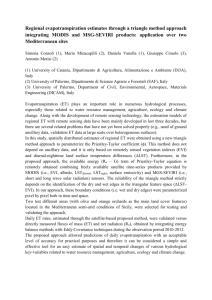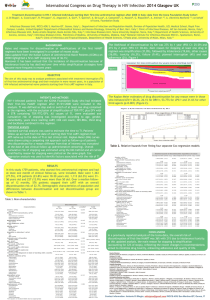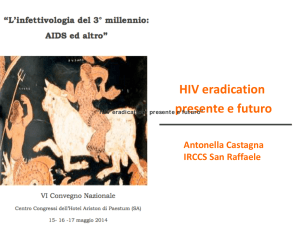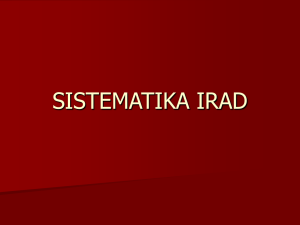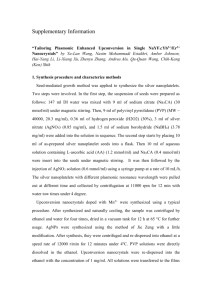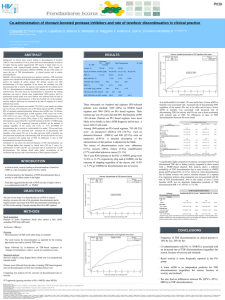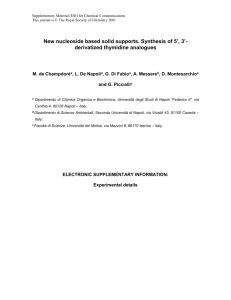Presentazione di PowerPoint
advertisement
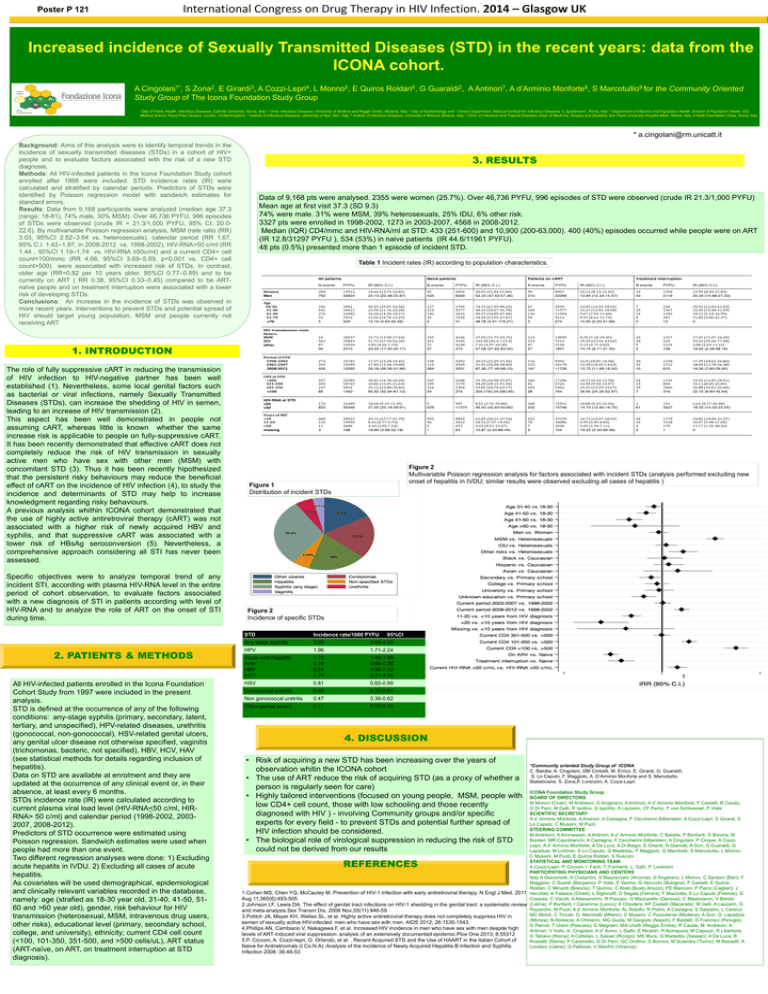
International Congress on Drug Therapy in HIV Infection. 2014 – Glasgow UK Poster P 121 Increased incidence of Sexually Transmitted Diseases (STD) in the recent years: data from the ICONA cohort. A Cingolani1*, S Zona2, E Girardi3, A Cozzi-Lepri4, L Monno5, E Quiros Roldan6, G Guaraldi2, A Antinori7, A d’Arminio Monforte8, S Marcotullio9 for the Community Oriented Study Group of The Icona Foundation Study Group 1Dep of Public Health, Infectious Diseases, Catholic University, Roma, Italy; 2 Clinic Infectious Diseases, Univeristy of Modena and Reggio Emilia, Modena, Italy; 3 Dep of Epidemiology and 7 Clinical Department, National Institute for Infectious Diseases “L.Spallanzani”, Roma, Italy; 4 Department of Infection and Population Health, Division of Population Health, UCL Medical School, Royal Free Campus, London, United Kingdom; 5 Insitute of Infectious Diseases, Univeristy of Bari, Bari, Italy; 6 Insitute of Infectious Diseases, University of Brescia, Brescia, Italy; 8 Clinic of Infectious and Tropical Diseases, Dept. of Medicine, Surgery and Dentistry, San Paolo University Hospital Milan, Milano, Italy, 9 Nadir Foundation Onlus, Roma, Italy * a.cingolani@rm.unicatt.it Background: Aims of this analysis were to identify temporal trends in the incidence of sexually transmitted diseases (STDs) in a cohort of HIV+ people and to evaluate factors associated with the risk of a new STD diagnosis. Methods: All HIV-infected patients in the Icona Foundation Study cohort enrolled after 1998 were included. STD incidence rates (IR) were calculated and stratified by calendar periods. Predictors of STDs were identified by Poisson regression model with sandwich estimates for standard errors. Results: Data from 9,168 participants were analyzed (median age 37.3 (range: 18-81), 74% male, 30% MSM). Over 46,736 PYFU, 996 episodes of STDs were observed (crude IR = 21.3/1,000 PYFU, 95% CI: 20.022.6). By multivariable Poisson regression analysis, MSM (rate ratio (RR) 3.03, 95%CI 2.52–3.64 vs. heterosexuals), calendar period (RR 1.67, 95% C.I. 1.42–1.97, in 2008-2012 vs. 1998-2002), HIV-RNA>50 c/ml (RR 1.44 , 95%CI 1.19–1.74 vs. HIV-RNA ≤50c/ml) and a current CD4+ cell count<100/mmc (RR 4.66, 95%CI 3.69–5.89, p<0.001 vs. CD4+ cell count>500) were associated with increased risk of STDs. In contrast, older age (RR=0.82 per 10 years older, 95%CI 0.77–0.89) and to be currently on ART ( RR 0.38, 95%CI 0.33–0.45) compared to be ARTnaïve people and on treatment interruption were associated with a lower risk of developing STDs. Conclusions: An increase in the incidence of STDs was observed in more recent years. Interventions to prevent STDs and potential spread of HIV should target young population, MSM and people currently not receiving ART 3. RESULTS Data of 9,168 pts were analysed. 2355 were women (25.7%). Over 46,736 PYFU, 996 episodes of STD were observed (crude IR 21.3/1,000 PYFU) Mean age at first visit 37.3 (SD 9.3) 74% were male. 31% were MSM, 39% heterosexuals, 25% IDU, 6% other risk. 3327 pts were enrolled in 1998-2002, 1273 in 2003-2007, 4568 in 2008-2012. Median (IQR) CD4/mmc and HIV-RNA/ml at STD: 433 (251-600) and 10,900 (200-63,000). 400 (40%) episodes occurred while people were on ART (IR 12.8/31297 PYFU ), 534 (53%) in naive patients (IR 44.6/11961 PYFU). 48 pts (0.5%) presented more than 1 episode of incident STD. Table 1 Incident rates (IR) according to population characteristics. 1. INTRODUCTION The role of fully suppressive cART in reducing the transmission of HIV infection to HIV-negative partner has been well established (1). Nevertheless, some local genital factors such as bacterial or viral infections, namely Sexually Transmitted Diseases (STDs), can increase the shedding of HIV in semen, leading to an increase of HIV transmission (2). This aspect has been well demonstrated in people not assuming cART, whereas little is known whether the same increase risk is applicable to people on fully-suppressive cART. It has been recently demonstrated that effective cART does not completely reduce the risk of HIV transmission in sexually active men who have sex with other men (MSM) with concomitant STD (3). Thus it has been recently hipothesized that the persistent risky behaviours may reduce the beneficial effect of cART on the incidence of HIV infection (4), to study the incidence and determinants of STD may help to increase knowledgment regarding risky behaviours. A previous analysis whithin ICONA cohort demonstrated that the use of highly active antiretroviral therapy (cART) was not associated with a higher risk of newly acquired HBV and syphilis, and that suppressive cART was associated with a lower risk of HBsAg seroconversion (5). Nevertheless, a comprehensive approach considering all STI has never been assessed. Specific objectives were to analyze temporal trend of any incident STI, according with plasma HIV-RNA level in the entire period of cohort observation, to evaluate factors associated with a new diagnosis of STI in patients according with level of HIV-RNA and to analyze the role of ART on the onset of STI during time. 2. PATIENTS & METHODS All HIV-infected patients enrolled in the Icona Foundation Cohort Study from 1997 were included in the present analysis. STD is defined at the occurrence of any of the following conditions: any-stage syphilis (primary, secondary, latent, tertiary, and unspecified), HPV-related diseases, urethritis (gonococcal, non-gonococcal), HSV-related genital ulcers, any genital ulcer disease not otherwise specified, vaginitis (trichomonas, bacteric, not specified), HBV, HCV, HAV (see statistical methods for details regarding inclusion of hepatitis). Data on STD are available at enrolment and they are updated at the occurrence of any clinical event or, in their absence, at least every 6 months. STDs incidence rate (IR) were calculated according to current plasma viral load level (HIV-RNA<50 c/ml, HIRRNA> 50 c/ml) and calendar period (1998-2002, 20032007, 2008-2012). Predictors of STD occurrence were estimated using Poisson regression. Sandwich estimates were used when people had more than one event. Two different regression analyses were done: 1) Excluding acute hepatits in IVDU. 2) Excluding all cases of acute hepatitis. As covariates will be used demographical, epidemiological and clinically relevant variables recorded in the database, namely: age (strafied as 18-30 year old, 31-40, 41-50, 5160 and >60 year old), gender, risk behaviour for HIV transmission (heterosexual, MSM, intravenous drug users, other risks), educational level (primary, secondary school, college, and university), ethnicity; current CD4 cell count (<100, 101-350, 351-500, and >500 cells/uL), ART status (ART-naïve, on ART, on treatment interruption at STD diagnosis). Figure 2 Multivariable Poisson regression analysis for factors associated with incident STDs (analysis performed excluding new onset of hepatitis in IVDU; similar results were observed excluding all cases of hepatitis ) Figure 1 Distribution of incident STDs Figure 2 Incidence of specific STDs STD Incidence rate/1000 PYFU 95%CI Any stage syphilis 3.95 3.59-4.35 HPV 1.96 1.71-2.24 Acute viral hepatitis HAV HBV HCV 1.72 0.19 6.54 3.74 1.49-1.99 0.09-0.36 5.83-7.32 3.21-4.34 HSV 0.81 0.65-0.99 Gonococcal uretritis 0.46 0.35-0.61 Non gonococcal uretritis 0.47 0.36-0.62 Other genital ulcers 0.11 0.06-0.19 > < 4. DISCUSSION • Risk of acquiring a new STD has been increasing over the years of observation whitin the ICONA cohort • The use of ART reduce the risk of acquiring STD (as a proxy of whether a person is regularly seen for care) • Highly tailored interventions (focused on young people, MSM, people with low CD4+ cell count, those with low schooling and those recently diagnosed with HIV ) - involving Community groups and/or specific experts for every field - to prevent STDs and potential further spread of HIV infection should be considered. • The biological role of virological suppression in reducing the risk of STD could not be derived from our results *Community oriented Study Group of ICONA C. Balotta, A. Cingolani, GM Corbelli, M. Errico, E. Girardi, G. Guaraldi, S. Lo Caputo, F. Maggiolo, A. D’Arminio Monforte and S. Marcotullio Statisticians: S. Zona,P. Lorenzini, A. Cozzi-Lepri ICONA Foundation Study Group BOARD OF DIRECTORS M Moroni (Chair), M Andreoni, G Angarano, A Antinori, A d’Arminio Monforte, F Castelli, R Cauda, G Di Perri, M Galli, R Iardino, G Ippolito, A Lazzarin, CF Perno, F von Schloesser, P Viale SCIENTIFIC SECRETARY A d’Arminio Monforte, A Antinori, A Castagna, F Ceccherini-Silberstein, A Cozzi-Lepri, E Girardi, S Lo Caputo, C Mussini, M Puoti STEERING COMMITTEE M Andreoni, A Ammassari, A Antinori, A d’Arminio Monforte, C Balotta, P Bonfanti, S Bonora, M Borderi, MR Capobianchi, A Castagna, F Ceccherini-Silberstein, A Cingolani, P Cinque, A CozziLepri, A d’Arminio Monforte, A De Luca, A Di Biagio, E Girardi, N Gianotti, A Gori, G Guaraldi, G Lapadula, M Lichtner, S Lo Caputo, G Madeddu, F Maggiolo, G Marchetti, S Marcotullio, L Monno, C Mussini, M Puoti, E Quiros Roldan, S Rusconi STATISTICAL AND MONITORING TEAM A.Cozzi-Lepri, P. Cicconi, I. Fanti, T. Formenti, L. Galli, P. Lorenzini PARTICIPATING PHYSICIANS AND CENTERS Italy A Giacometti, A Costantini, S Mazzoccato (Ancona); G Angarano, L Monno, C Santoro (Bari); F Maggiolo, C Suardi (Bergamo); P Viale, E Vanino, G Verucchi (Bologna); F Castelli, E Quiros . Roldan, C Minardi (Brescia); T Quirino, C Abeli (Busto Arsizio); PE Manconi, P Piano (Cagliari); J 1.Cohen MS, Chen YQ, McCauley M. Prevention of HIV-1 infection with early antiretroviral therapy. N Engl J Med. 2011 Vecchiet, K Falasca (Chieti); L Sighinolfi, D Segala (Ferrara); F Mazzotta, S Lo Caputo (Firenze); G Aug 11;365(6):493-505. Cassola, C Viscoli, A Alessandrini, R Piscopo, G Mazzarello (Genova); C Mastroianni, V Belvisi 2.Johnson LF, Lewis DA. The effect of genital tract infections on HIV-1 shedding in the genital tract: a systematic review (Latina); P Bonfanti, I Caramma (Lecco); A Chiodera, AP Castelli (Macerata); M Galli, A Lazzarin, G Rizzardini, M Puoti, A d’Arminio Monforte, AL Ridolfo, R Piolini, A Castagna, S Salpietro, L Carenzi, and meta-analysis.Sex Transm Dis. 2008 Nov;35(11):946-59 MC Moioli, C Tincati, G. Marchetti (Milano); C Mussini, C Puzzolante (Modena); A Gori, G. Lapadula 3.Politch JA, Mayer KH, Welles SL, et al. Highly active antiretroviral therapy does not completely suppress HIV in (Monza); N Abrescia, A Chirianni, MG Guida, M Gargiulo (Napoli); F Baldelli, D Francisci (Perugia); semen of sexually active HIV-infected men who have sex with men. AIDS 2012; 26:1535-1543. G Parruti, T Ursini (Pescara); G Magnani, MA Ursitti (Reggio Emilia); R Cauda, M. Andreoni, A 4.Phillips AN, Cambiano V, Nakagawa F, et al. Increased HIV incidence in men who have sex with men despite high Antinori, V Vullo, A. Cingolani, A d’Avino, L Gallo, E Nicastri, R Acinapura, M Capozzi, R Libertone, levels of ART-induced viral suppression: analysis of an extensively documented epidemic.Plos One 2013; 8:55312 G Tebano (Roma); A Cattelan, L Sasset (Rovigo); MS Mura, G Madeddu (Sassari); A De Luca, B 5.P. Cicconi, A. Cozzi-lepri, G. Orlando, et al. . Recent Acquired STD and the Use of HAART in the Italian Cohort of Rossetti (Siena); P Caramello, G Di Perri, GC Orofino, S Bonora, M Sciandra (Torino); M Bassetti, A Naive for Antiretrovirals (I.Co.N.A): Analysis of the Incidence of Newly Acquired Hepatitis B Infection and Syphilis. Londero (Udine); G Pellizzer, V Manfrin (Vicenza). REFERENCES Infection 2008: 36:46-53
